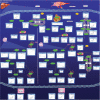SMPDB: The Small Molecule Pathway Database
- PMID: 19948758
- PMCID: PMC2808928
- DOI: 10.1093/nar/gkp1002
SMPDB: The Small Molecule Pathway Database
Abstract
The Small Molecule Pathway Database (SMPDB) is an interactive, visual database containing more than 350 small-molecule pathways found in humans. More than 2/3 of these pathways (>280) are not found in any other pathway database. SMPDB is designed specifically to support pathway elucidation and pathway discovery in clinical metabolomics, transcriptomics, proteomics and systems biology. SMPDB provides exquisitely detailed, hyperlinked diagrams of human metabolic pathways, metabolic disease pathways, metabolite signaling pathways and drug-action pathways. All SMPDB pathways include information on the relevant organs, organelles, subcellular compartments, protein cofactors, protein locations, metabolite locations, chemical structures and protein quaternary structures. Each small molecule is hyperlinked to detailed descriptions contained in the Human Metabolome Database (HMDB) or DrugBank and each protein or enzyme complex is hyperlinked to UniProt. All SMPDB pathways are accompanied with detailed descriptions, providing an overview of the pathway, condition or processes depicted in each diagram. The database is easily browsed and supports full text searching. Users may query SMPDB with lists of metabolite names, drug names, genes/protein names, SwissProt IDs, GenBank IDs, Affymetrix IDs or Agilent microarray IDs. These queries will produce lists of matching pathways and highlight the matching molecules on each of the pathway diagrams. Gene, metabolite and protein concentration data can also be visualized through SMPDB's mapping interface. All of SMPDB's images, image maps, descriptions and tables are downloadable. SMPDB is available at: http://www.smpdb.ca.
Figures

References
-
- Michal G. On representation of metabolic pathways. Biosystems. 1998;47:1–7. - PubMed
-
- Michal G. Biochemical Pathways Wall Chart. Germany: Boehringer Mannheim GmbH; 1968.
-
- Ideker T, Galitski T, Hood L. A new approach to decoding life: systems biology. Annu. Rev. Genomics Hum. Genet. 2001;2:343–372. - PubMed
-
- Suderman M, Hallett M. Tools for visually exploring biological networks. Bioinformatics. 2007;23:2651–2659. - PubMed
Publication types
MeSH terms
Substances
Grants and funding
LinkOut - more resources
Full Text Sources
Other Literature Sources

